Experimental Investigation on the Tensile Strength of Coal: Consideration of the Specimen Size and Water Content
Abstract
1. Introduction
2. Effects of Water on Coal
- (1)
- (2)
- (3)
3. Experimental Work
3.1. Coal Sample Properties
3.2. Specimen Preparation
3.3. Immersion Experiment
3.4. SEM Measurements
3.5. Brazilian Splitting Test and AE Measurements
4. Results and Discussion
4.1. Tensile Strength Variations
4.2. Weakening Effects of Water Content and Specimen Size
4.3. AE Variations with Specimen Size and Water Content
4.4. Failure Pattern Variations Due to Specimen Size and Water Content
4.5. Fractal Characteristic Variations Due to Specimen Size and Water Content
4.6. Correlations between Specimen Size and Tensile Strength in Coal
5. Conclusions
- (1)
- The tensile strength decreases in larger specimens, while the tensile strength variations due to specimen diameter differences can be described by an exponential correlation function, although the immersion times are different;
- (2)
- Water strengthens the scale effect on the tensile strength in coal. Greater reductions in tensile strength occur due to the mutual effects of water and specimen size under the discrete effects of each factor. The water content decreases in larger specimens with the same amount of immersion time;
- (3)
- The cumulative AE counts and absolute AE energy values increased in larger specimens, while these values decreased as the immersion time length increased. Similar behavior was also observed in the fractal dimension for AE activities. The concentration intensity of AE activities around the peak strength period increased as the immersion time elapsed, while relatively less obvious concentrations of AE events in larger specimens were observed;
- (4)
- The percentage of tensile failure AE activities increased in the specimen diameter range of 25–38 mm, while the percentage decreased in the range of 38–50 mm. The proportion of tensile failures increased as the immersion time increased. Water was considered to play significant roles in dissolving clay minerals, softening the coal matrix, and lubricating cracks during the tensile failure of coal in the specimen diameter range of 25–50 mm.
Author Contributions
Funding
Conflicts of Interest
References
- Bieniawski, Z.T.H. Suggested methods for determining tensile strength of rock materials. Int. J. Rock Mech. Min. Sci. Geomech. Abstr. 1978, 15, 99–103. [Google Scholar]
- Dai, F.; Xia, K. Loading Rate Dependence of Tensile Strength Anisotropy of Barre Granite. Pure Appl. Geophys. 2010, 167, 1419–1432. [Google Scholar] [CrossRef]
- Wong, L.N.Y.; Maruvanchery, V.; Liu, G. Water effects on rock strength and stiffness degradation. Acta Geotech. 2016, 11, 713–737. [Google Scholar] [CrossRef]
- Zhao, Y.; Liu, S.; Jiang, Y.; Wang, K.; Huang, Y. Dynamic Tensile Strength of Coal under Dry and Saturated Conditions. Rock Mech. Rock Eng. 2016, 49, 1709–1720. [Google Scholar] [CrossRef]
- Masoumi, H.; Roshan, H.; Hedayat, A.; Hagan, P.C. Scale-Size Dependency of Intact Rock under Point-Load and Indirect Tensile Brazilian Testing. Int. J. Geomech. 2018, 18, 4018006. [Google Scholar] [CrossRef]
- Liu, S.; Li, W.; Wang, Q. Height of the Water-Flowing Fractured Zone of the Jurassic Coal Seam in Northwestern China. Mine Water Environ. 2018, 37, 312–321. [Google Scholar] [CrossRef]
- Guanhua, N.; Hongchao, X.; Zhao, L.; Lingxun, Z.; Yunyun, N. Improving the permeability of coal seam with pulsating hydraulic fracturing technique: A case study in Changping coal mine, China. Process Saf. Environ. Prot. 2018, 117, 565–572. [Google Scholar] [CrossRef]
- Guo, H.; Yuan, L.; Cheng, Y.; Wang, K.; Xu, C.; Zhou, A.; Zang, J.; Liu, J. Effect of moisture on the desorption and unsteady-state diffusion properties of gas in low-rank coal. J. Nat. Gas Sci. Eng. 2018, 57, 45–51. [Google Scholar] [CrossRef]
- Bieniawski, Z.T. The effect of specimen size on compressive strength of coal. Int. J. Rock Mech. Min. Sci. Geomech. Abstr. 1968, 5, 325–335. [Google Scholar] [CrossRef]
- Scholtès, L.; Donzé, F.-V.; Khanal, M. Scale effects on strength of geomaterials, case study: Coal. J. Mech. Phys. Solids 2011, 59, 1131–1146. [Google Scholar] [CrossRef]
- Zhang, C.; Tu, S.; Bai, Q. Evaluation of Pore Size and Distribution Impacts on Uniaxial Compressive Strength of Lithophysal Rock. Arab. J. Sci. Eng. 2018, 43, 1235–1246. [Google Scholar] [CrossRef]
- Zhao, Y.; Liu, S.; Zhao, G.-F.; Elsworth, D.; Jiang, Y.; Han, J. Failure mechanisms in coal: Dependence on strain rate and microstructure. J. Geophys. Res. Solid Earth 2014, 119, 6924–6935. [Google Scholar] [CrossRef]
- Ai, D.; Zhao, Y.; Wang, Q.; Li, C. Crack propagation and dynamic properties of coal under SHPB impact loading: Experimental investigation and numerical simulation. Theor. Appl. Fract. Mech. 2020, 105, 102393. [Google Scholar] [CrossRef]
- Masoumi, H.; Saydam, S.; Hagan, P.C. Unified Size-Effect Law for Intact Rock. Int. J. Geomech. 2016, 16, 4015059. [Google Scholar] [CrossRef]
- Yu, Y.; Yin, J.; Zhong, Z. Shape effects in the Brazilian tensile strength test and a 3D FEM correction. Int. J. Rock Mech. Min. Sci. 2006, 43, 623–627. [Google Scholar] [CrossRef]
- Liu, H.; Zhu, W.; Yu, Y.; Xu, T.; Li, R.; Liu, X. Effect of water imbibition on uniaxial compression strength of sandstone. Int. J. Rock Mech. Min. Sci. 2020, 127, 104200. [Google Scholar] [CrossRef]
- Nara, Y.; Tanaka, M.; Harui, T. Evaluating long-term strength of rock under changing environments from air to water. Eng. Fract. Mech. 2017, 178, 201–211. [Google Scholar] [CrossRef]
- Vásárhelyi, B.; Ván, P. Influence of water content on the strength of rock. Eng. Geol. 2006, 84, 70–74. [Google Scholar] [CrossRef]
- Jia, J.; Liu, Z.; Feng, W.; Ma, F.; Zheng, C.; Wang, Y. Water Pressure Induced Corrosion of Cemented Sand, Gravel, and Rock (CSGR). Arab. J. Sci. Eng. 2018, 43, 2083–2092. [Google Scholar] [CrossRef]
- Rossi, P. A physical phenomenon which can explain the mechanical behaviour of concrete under high strain rates. Mater. Struct. 1991, 24, 422–424. [Google Scholar] [CrossRef]
- Zhang, Q.B.; Zhao, J. A review of dynamic experimental techniques and mechanical behaviour of rock materials. Rock Mech. Rock Eng. 2014, 47, 1411–1478. [Google Scholar] [CrossRef]
- Masuda, K. Effects of water on rock strength in a brittle regime. J. Struct. Geol. 2001, 23, 1653–1657. [Google Scholar] [CrossRef]
- Gu, H.; Tao, M.; Cao, W.; Zhou, J.; Li, X. Dynamic fracture behaviour and evolution mechanism of soft coal with different porosities and water contents. Theor. Appl. Fract. Mech. 2019, 103, 102265. [Google Scholar] [CrossRef]
- Dyke, C.G.; Dobereiner, L. Evaluating the strength and deformability of sandstones. Q. J. Eng. Geol. Hydrogeol. 1991, 24, 123–134. [Google Scholar] [CrossRef]
- Ramos da Silva, M.; Schroeder, C.; Verbrugge, J.-C. Unsaturated rock mechanics applied to a low-porosity shale. Eng. Geol. 2008, 97, 42–52. [Google Scholar] [CrossRef]
- Dresen, G.; Stephansson, O.; Zang, A. Rock Damage and Fluid Transport, Part I (Pageoph Topical Volumes); Springer Scienc: Berlin, Germany, 2006; Volume 278. [Google Scholar] [CrossRef]
- Charrière, D.; Behra, P. Water sorption on coals. J. Colloid Interface Sci. 2010, 344, 460–467. [Google Scholar] [CrossRef]
- Yao, Q.; Chen, T.; Tang, C.; Sedighi, M.; Wang, S.; Huang, Q. Influence of moisture on crack propagation in coal and its failure modes. Eng. Geol. 2019, 258, 105156. [Google Scholar] [CrossRef]
- Da S. Machado, A.; Mexias, A.S.; Vilela, A.C.F.; Osorio, E. Study of coal, char and coke fines structures and their proportions in the off-gas blast furnace samples by X-ray diffraction. Fuel 2013, 114, 224–228. [Google Scholar] [CrossRef]
- Song, D.; Yang, C.; Zhang, X.; Su, X.; Zhang, X. Structure of the organic crystallite unit in coal as determined by X-ray diffraction. Min. Sci. Technol. 2011, 21, 667–671. [Google Scholar] [CrossRef]
- Ward, C.R.; Taylor, J.C.; Matulis, C.E.; Dale, L.S. Quantification of mineral matter in the Argonne Premium Coals using interactive Rietveld-based X-ray diffraction. Int. J. Coal Geol. 2001, 46, 67–82. [Google Scholar] [CrossRef]
- Creelman, R.A.; Ward, C.R. A scanning electron microscope method for automated, quantitative analysis of mineral matter in coal. Int. J. Coal Geol. 1996, 30, 249–269. [Google Scholar] [CrossRef]
- Roslin, A.; Pokrajac, D.; Zhou, Y. Cleat structure analysis and permeability simulation of coal samples based on micro-computed tomography (micro-CT) and scan electron microscopy (SEM) technology. Fuel 2019, 254, 115579. [Google Scholar] [CrossRef]
- Shen, R.; Qiu, L.; Zhao, E.; Han, X.; Li, H.; Hou, Z.; Zhang, X. Experimental study on frequency and amplitude characteristics of acoustic emission during the fracturing process of coal under the action of water. Saf. Sci. 2019, 117, 320–329. [Google Scholar] [CrossRef]
- Li, D.; Wang, E.; Kong, X.; Ali, M.; Wang, D. Mechanical behaviors and acoustic emission fractal characteristics of coal specimens with a pre-existing flaw of various inclinations under uniaxial compression. Int. J. Rock Mech. Min. Sci. 2019, 116, 38–51. [Google Scholar] [CrossRef]
- Lockner, D. The role of acoustic emission in the study of rock fracture. Int. J. Rock Mech. Min. Sci. Geomech. Abstr. 1993, 30, 883–899. [Google Scholar] [CrossRef]
- Faria, M.T.C.; Pimentel-Junior, G.L.S. On the Crack Propagation in Rotating Shafts Supported by Fluid Film Bearings Using High-Frequency Acoustic Emission Analysis. Arab. J. Sci. Eng. 2019, 44, 1709–1712. [Google Scholar] [CrossRef]
- Wang, C.; Wu, S.; Lv, Q.; Liu, X.; Chen, W.; Che, D. Study on correlations of coal chemical properties based on database of real-time data. Appl. Energy 2017, 204, 1115–1123. [Google Scholar] [CrossRef]
- Le Roux, M.; Campbell, Q.P. An investigation into an improved method of fine coal dewatering. Miner. Eng. 2003, 16, 999–1003. [Google Scholar] [CrossRef]
- Yu, J.; Tahmasebi, A.; Han, Y.; Yin, F.; Li, X. A review on water in low rank coals: The existence, interaction with coal structure and effects on coal utilization. Fuel Process. Technol. 2013, 106, 9–20. [Google Scholar] [CrossRef]
- Dai, S.; Hower, J.C.; Finkelman, R.B.; Graham, I.T.; French, D.; Ward, C.R.; Eskenazy, G.; Wei, Q.; Zhao, L. Organic associations of non-mineral elements in coal: A review. Int. J. Coal Geol. 2020, 218, 103347. [Google Scholar] [CrossRef]
- Suuberg, E.M.; Otake, Y.; Yun, Y.; Deevi, S.C. Role of moisture in coal structure and the effects of drying upon the accessibility of coal structure. Energy Fuels 1993, 7, 384–392. [Google Scholar] [CrossRef]
- Zhong, C.; Zhang, Z.; Ranjith, P.G.; Lu, Y.; Choi, X. The role of pore water plays in coal under uniaxial cyclic loading. Eng. Geol. 2019, 257, 105125. [Google Scholar] [CrossRef]
- Okubo, S.; Fukui, K.; Qingxin, Q. Uniaxial compression and tension tests of anthracite and loading rate dependence of peak strength. Int. J. Coal Geol. 2006, 68, 196–204. [Google Scholar] [CrossRef]
- Song, H.; Jiang, Y.; Elsworth, D.; Zhao, Y.; Wang, J.; Liu, B. Scale effects and strength anisotropy in coal. Int. J. Coal Geol. 2018, 195, 37–46. [Google Scholar] [CrossRef]
- Zhao, Y.; Song, H.; Liu, S.; Zhang, C.; Dou, L.; Cao, A. Mechanical anisotropy of coal with considerations of realistic microstructures and external loading directions. Int. J. Rock Mech. Min. Sci. 2019, 116, 111–121. [Google Scholar] [CrossRef]
- Liu, Y.; Yin, G.; Li, M.; Zhang, D.; Huang, G.; Liu, P.; Liu, C.; Zhao, H.; Yu, B. Mechanical Properties and Failure Behavior of Dry and Water-Saturated Anisotropic Coal Under True-Triaxial Loading Conditions. Rock Mech. Rock Eng. 2019. [Google Scholar] [CrossRef]
- Yang, J.; Dai, J.; Yao, C.; Jiang, S.; Zhou, C.; Jiang, Q. Estimation of rock mass properties in excavation damage zones of rock slopes based on the Hoek-Brown criterion and acoustic testing. Int. J. Rock Mech. Min. Sci. 2020, 126, 104192. [Google Scholar] [CrossRef]
- Zhou, Z.; Cai, X.; Ma, D.; Cao, W.; Chen, L.; Zhou, J. Effects of water content on fracture and mechanical behavior of sandstone with a low clay mineral content. Eng. Fract. Mech. 2018, 193, 47–65. [Google Scholar] [CrossRef]
- Aggelis, D.G. Classification of cracking mode in concrete by acoustic emission parameters. Mech. Res. Commun. 2011, 38, 153–157. [Google Scholar] [CrossRef]
- Ohno, K.; Ohtsu, M. Crack classification in concrete based on acoustic emission. Constr. Build. Mater. 2010, 24, 2339–2346. [Google Scholar] [CrossRef]
- Yao, Q.; Tang, C.; Xia, Z.; Liu, X.; Zhu, L.; Chong, Z.; Hui, X. Mechanisms of failure in coal samples from underground water reservoir. Eng. Geol. 2020, 267, 105494. [Google Scholar] [CrossRef]
- Ahmed, Q.; Knez, D. Sensitivity Analysis on Fracturing Pressure Using Monte Carlo Simulation Technique. Oil Gas Eur. Mag. 2016, 42, 140–144. [Google Scholar]
- Quosay, A.A.; Knez, D.; Ziaja, J. Hydraulic fracturing: New uncertainty based modeling approach for process design using Monte Carlo simulation technique. PLoS ONE 2020, 15, e0236726. [Google Scholar] [CrossRef] [PubMed]
- Kong, X.; Wang, E.; Hu, S.; Shen, R.; Li, X.; Zhan, T. Fractal characteristics and acoustic emission of coal containing methane in triaxial compression failure. J. Appl. Geophys. 2016, 124, 139–147. [Google Scholar] [CrossRef]
- Xie, H.; Liu, J.; Ju, Y.; Li, J.; Xie, L. Fractal property of spatial distribution of acoustic emissions during the failure process of bedded rock salt. Int. J. Rock Mech. Min. Sci. 2011, 48, 1344–1351. [Google Scholar] [CrossRef]
- Zhang, Z.; Wang, E.; Li, N. Fractal characteristics of acoustic emission events based on single-link cluster method during uniaxial loading of rock. Chaos Solitons Fractals 2017, 104, 298–306. [Google Scholar] [CrossRef]
- Grassberger, P.; Procaccia, I. Measuring the strangeness of strange attractors. Phys. D Nonlinear Phenom. 1983, 9, 189–208. [Google Scholar] [CrossRef]
- Song, H.; Zhao, Y.; Jiang, Y.; Wang, J. Scale Effect on the Anisotropy of Acoustic Emission in Coal. Shock Vib. 2018, 2018, 11–21. [Google Scholar] [CrossRef]
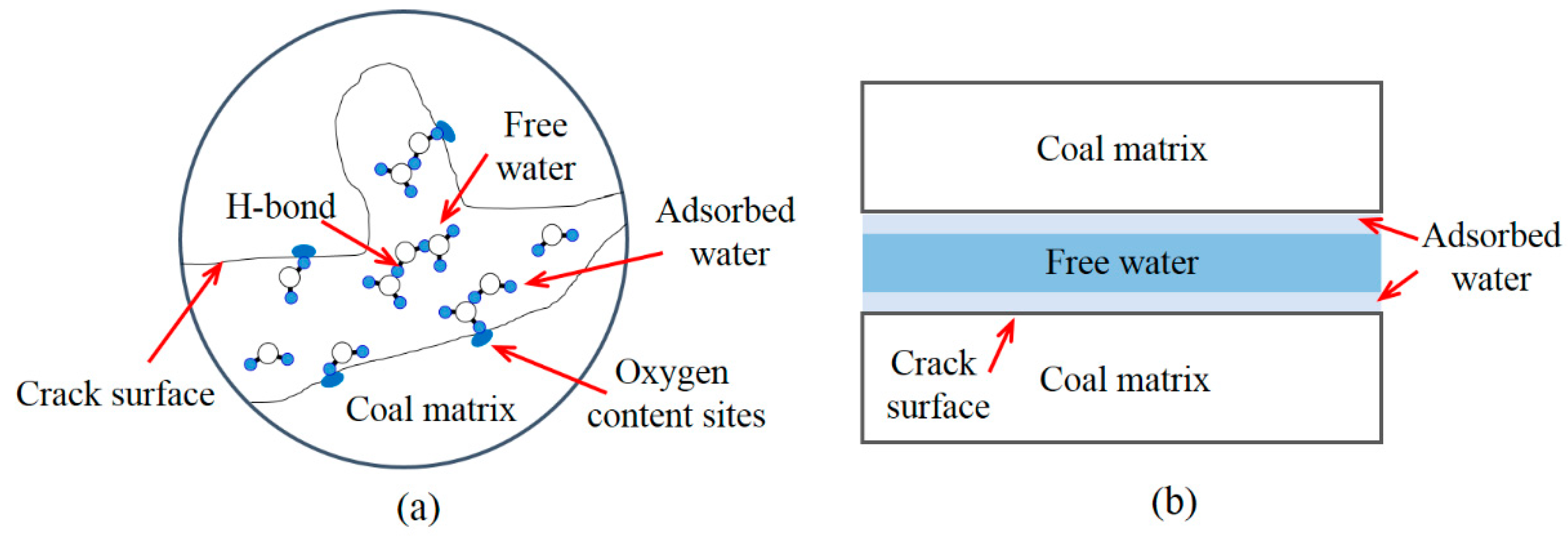
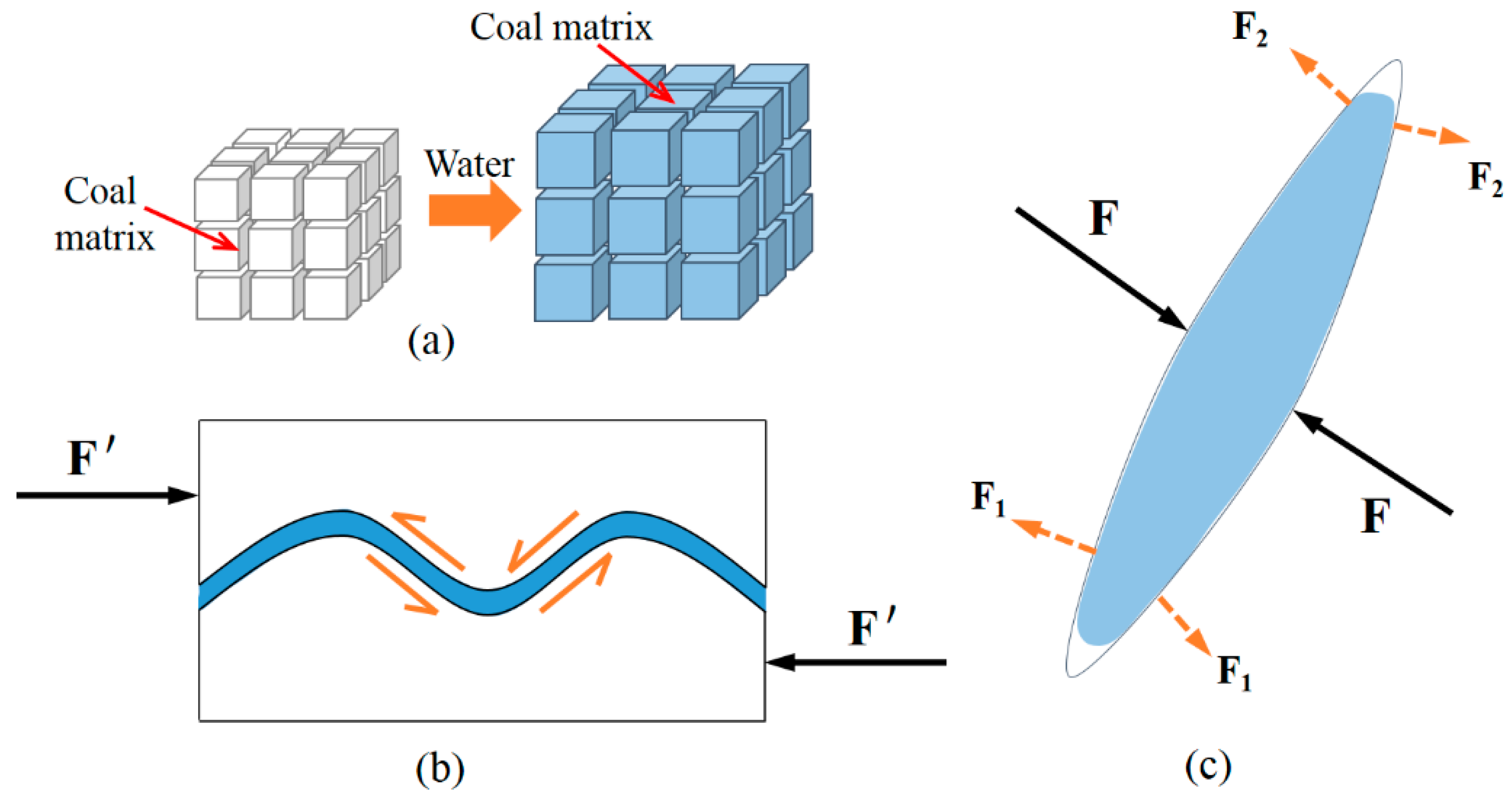
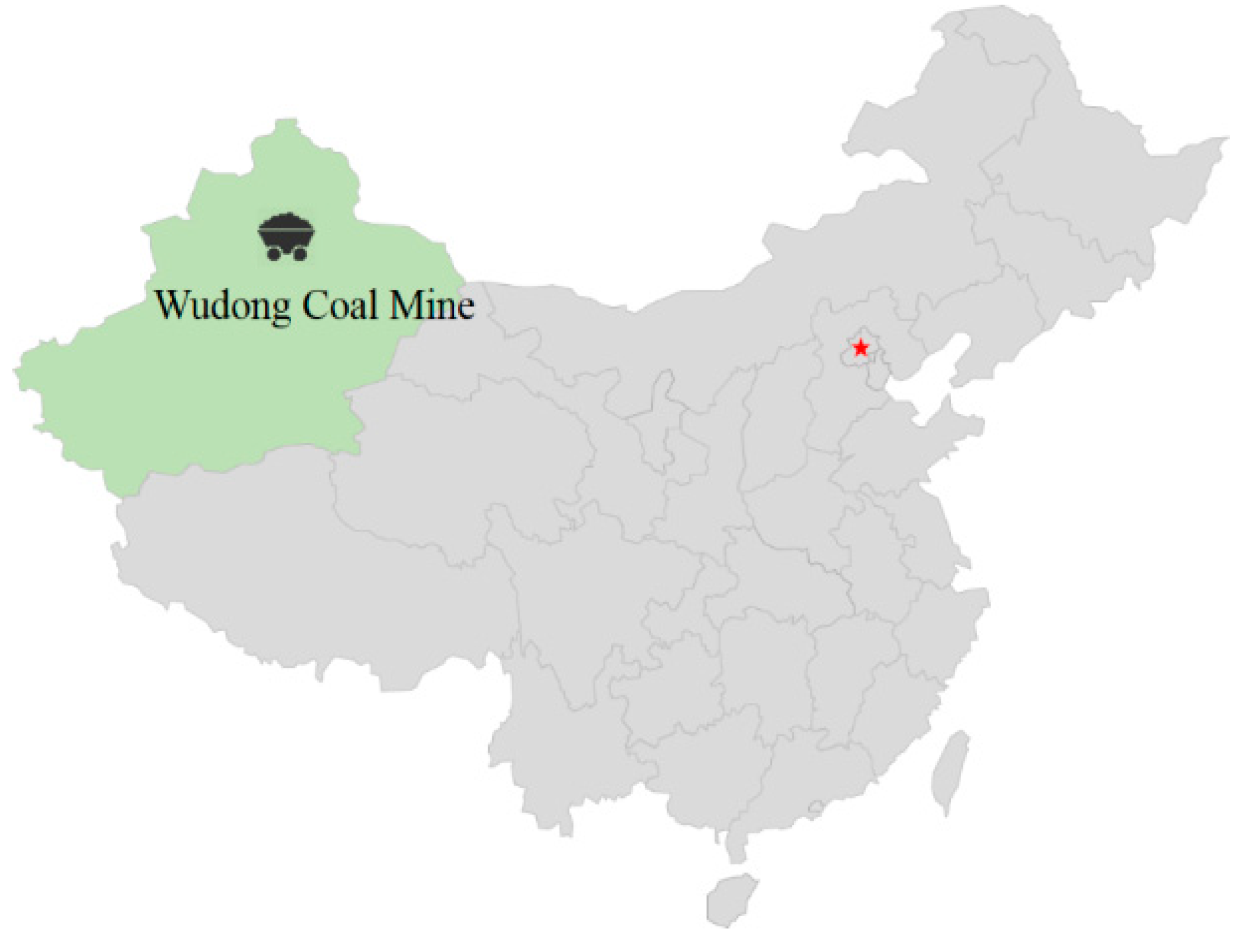
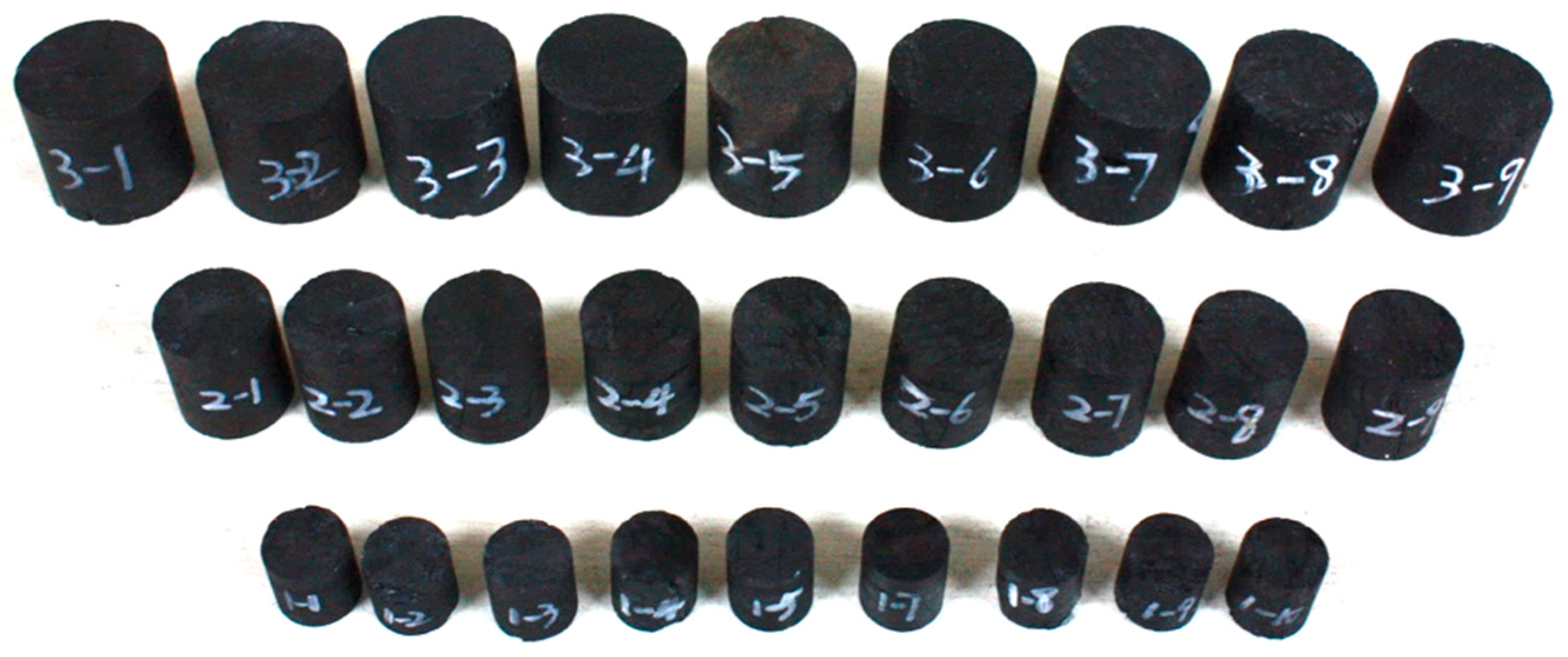
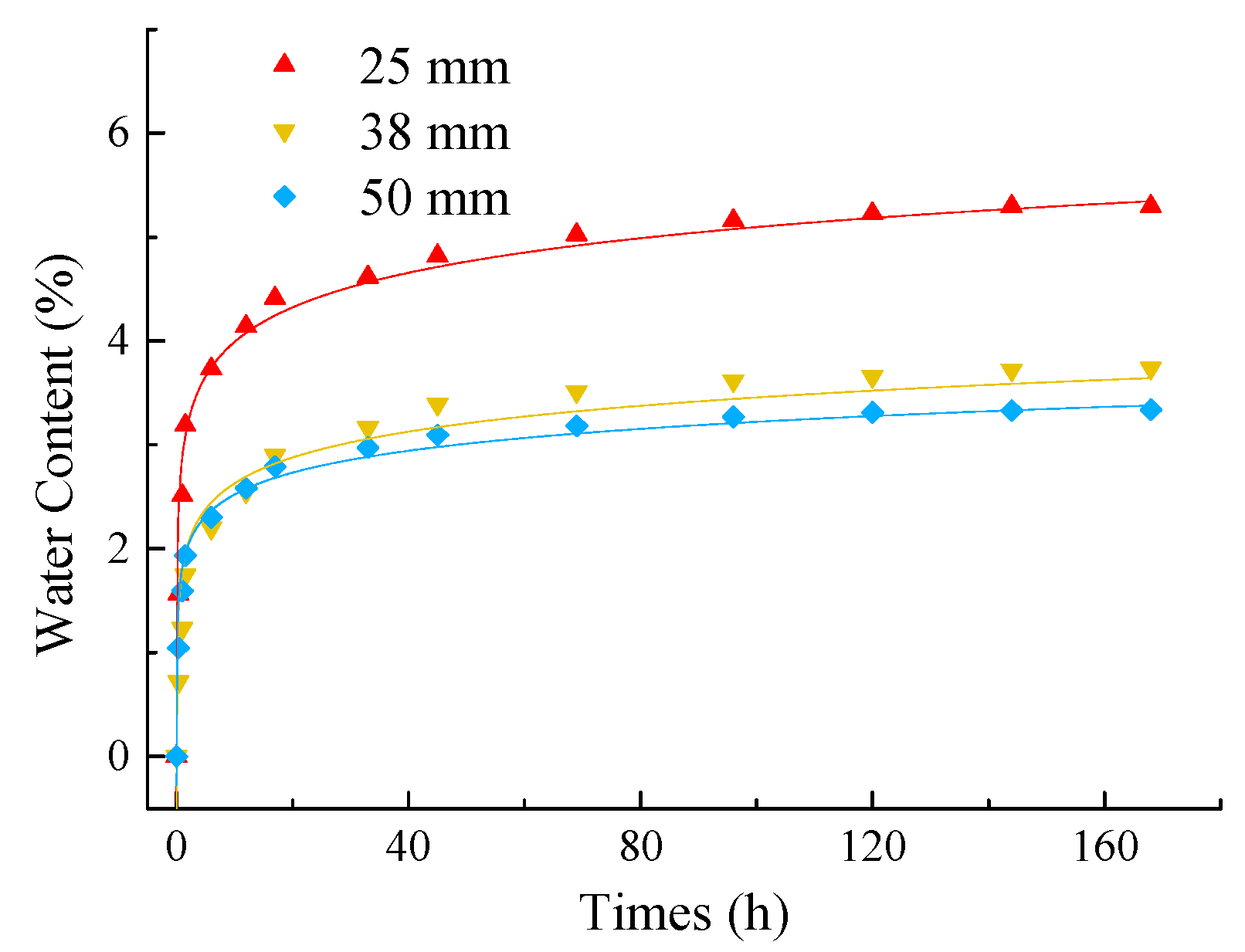

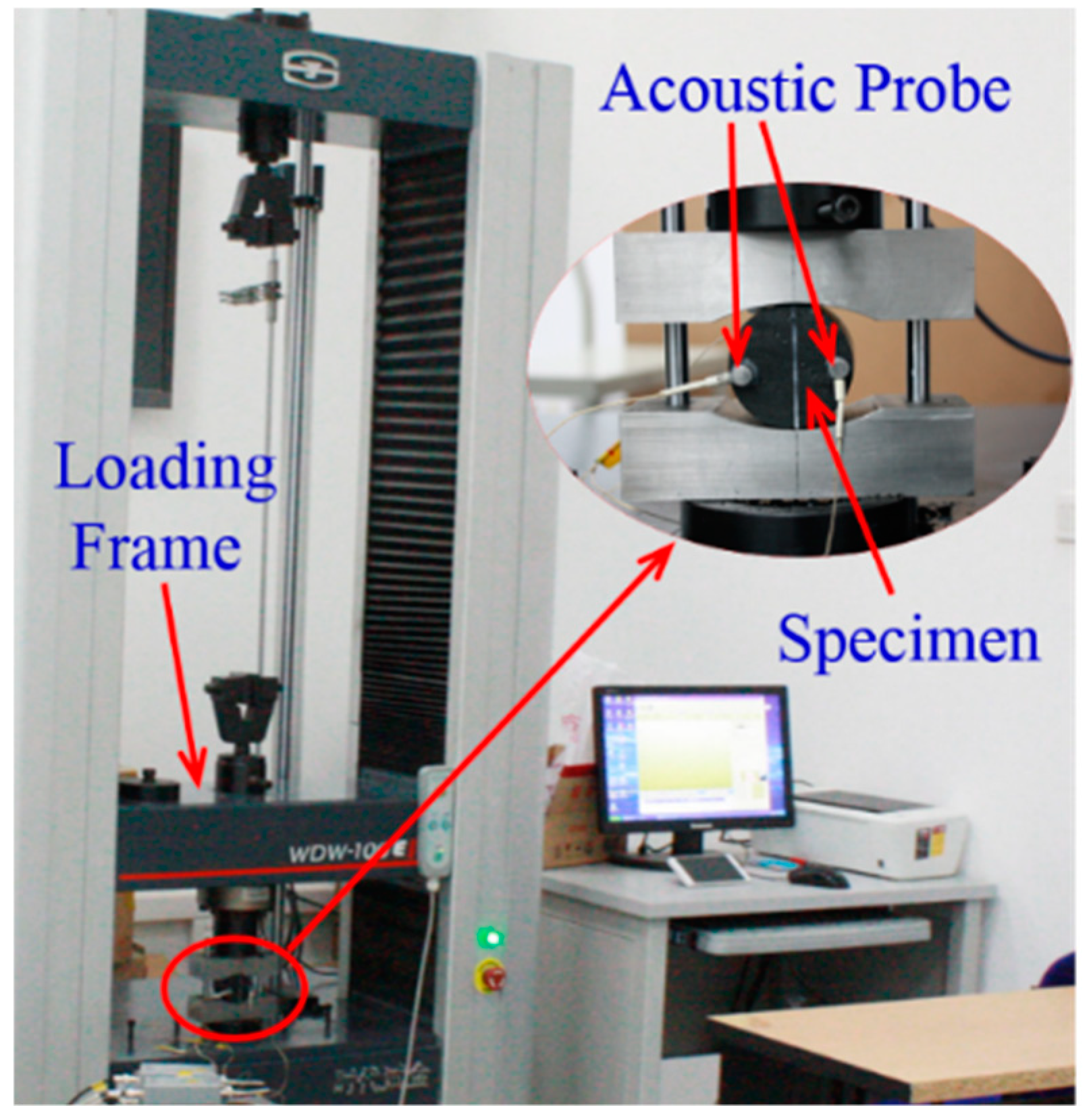
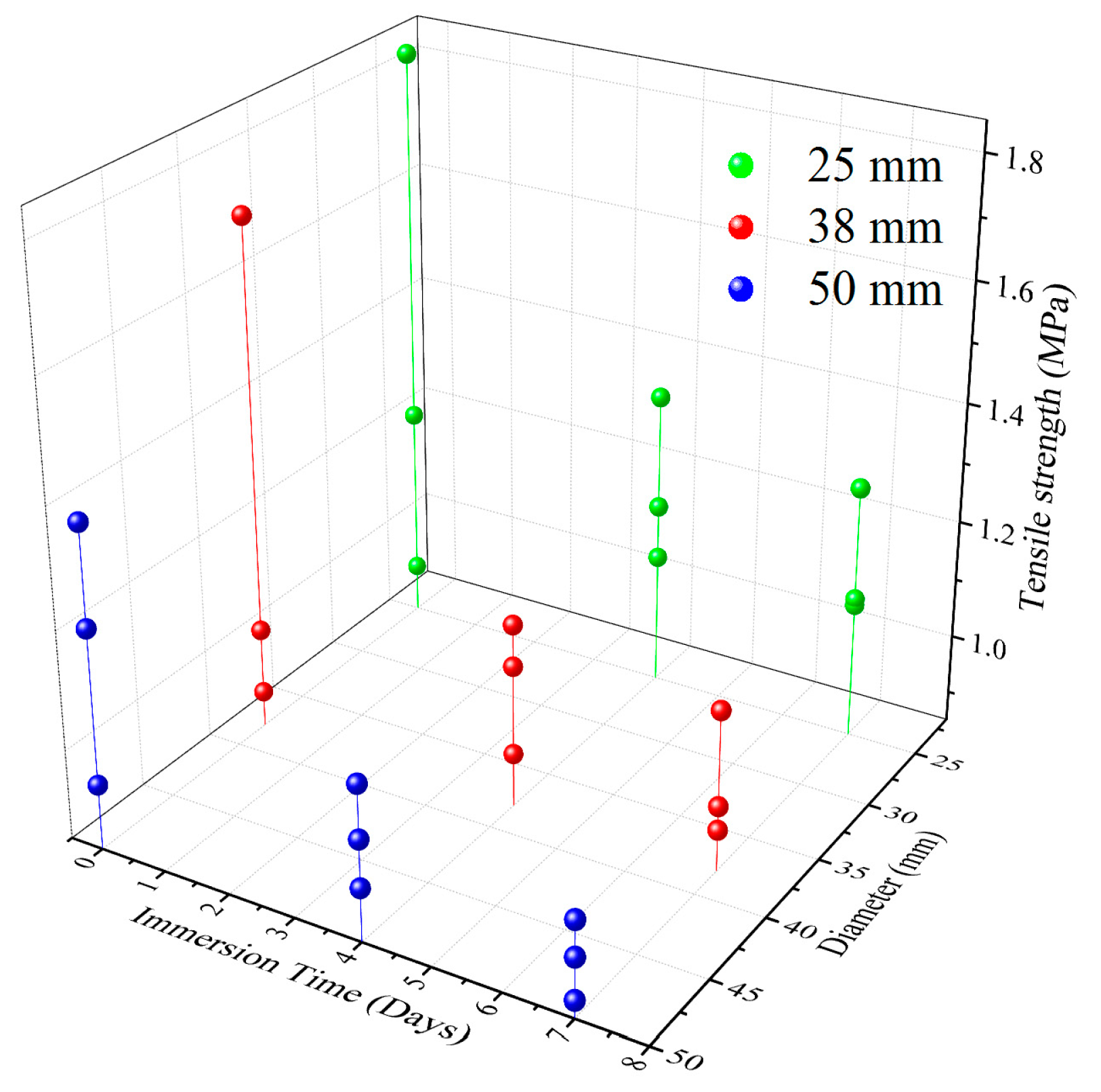
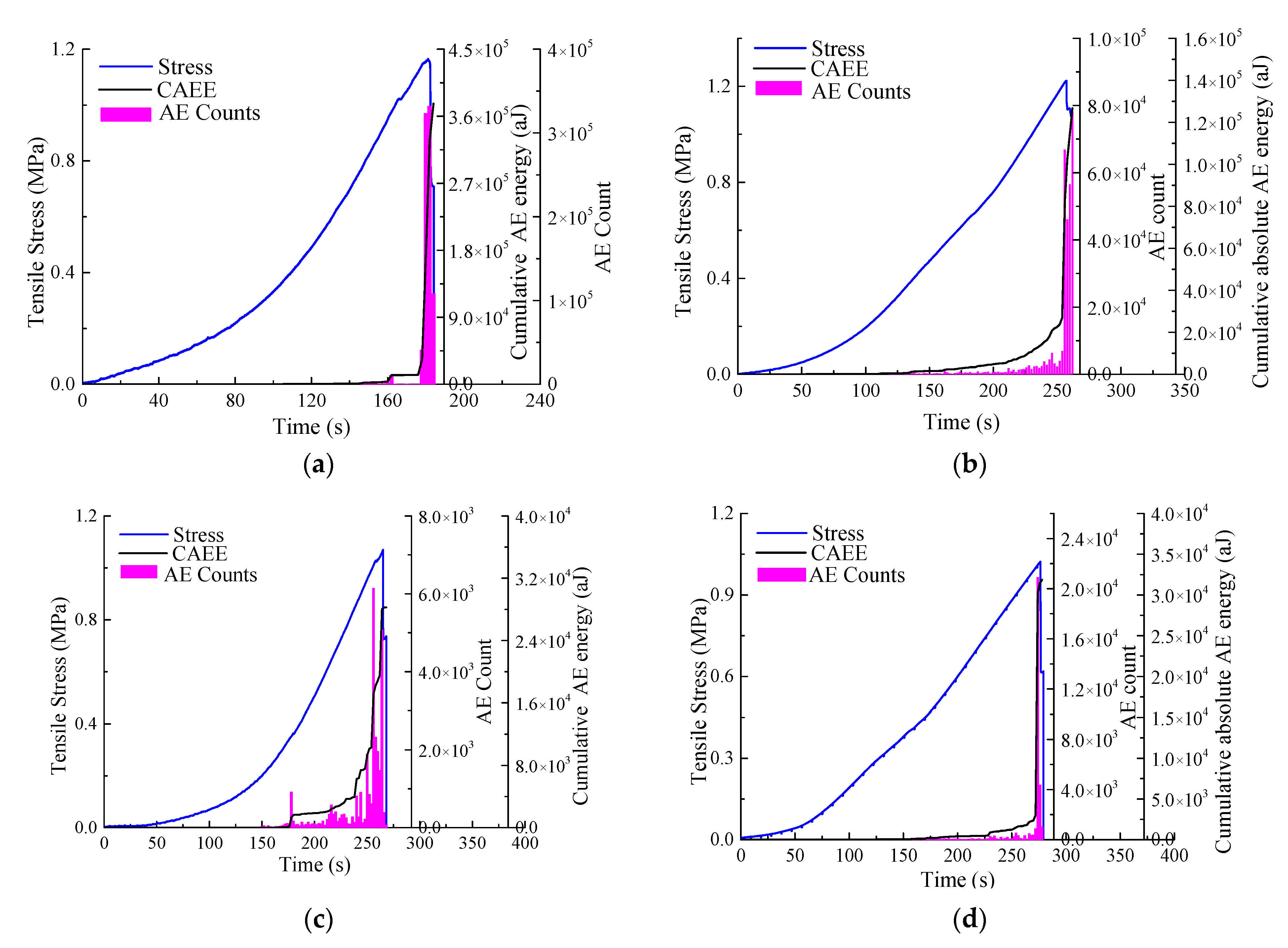
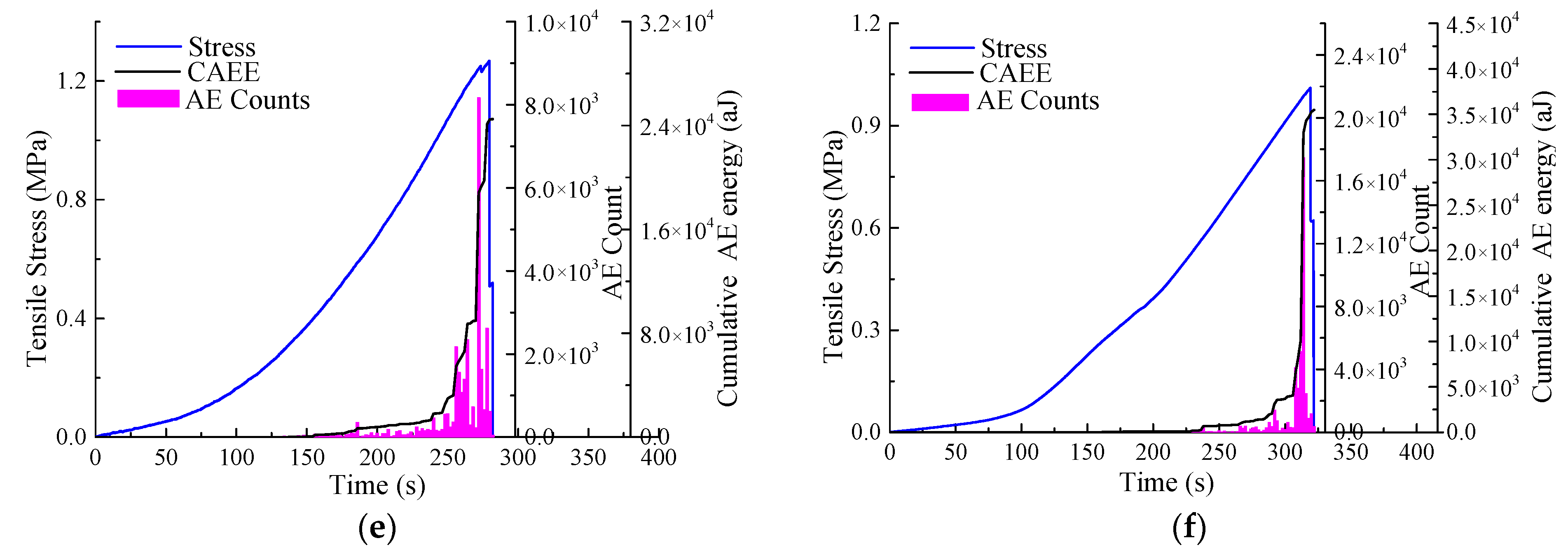
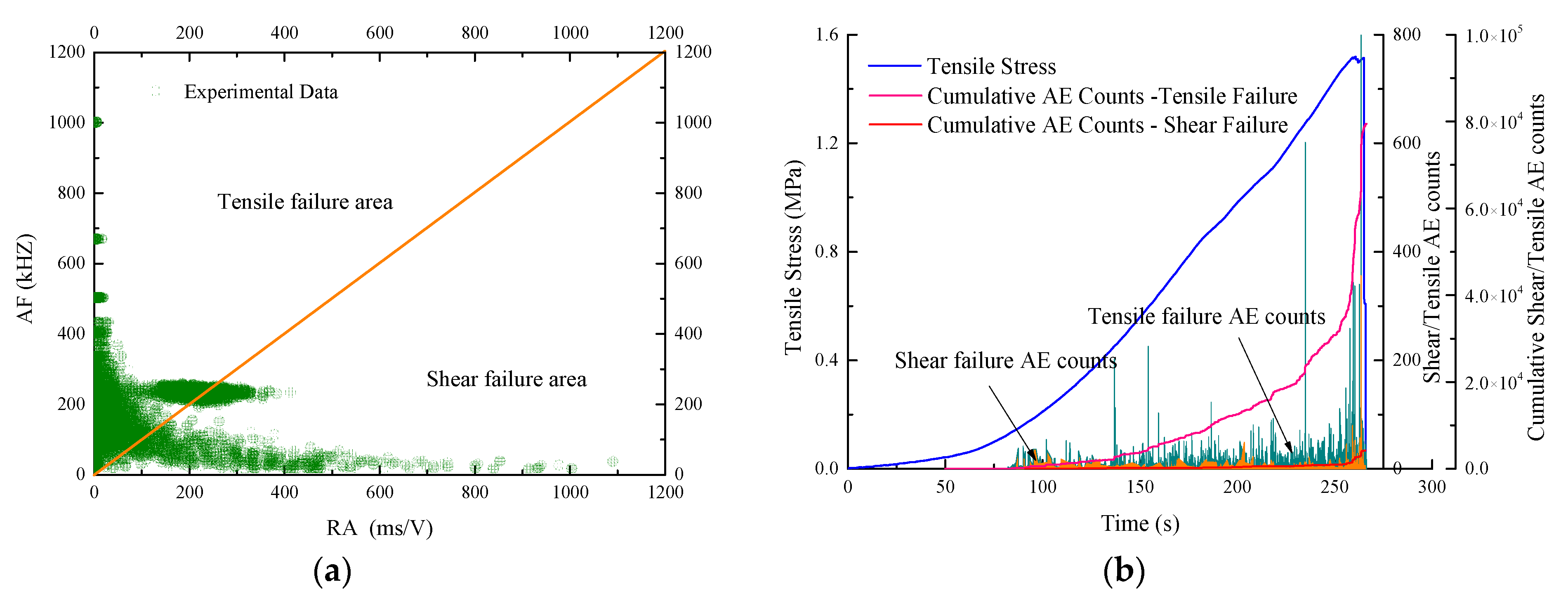
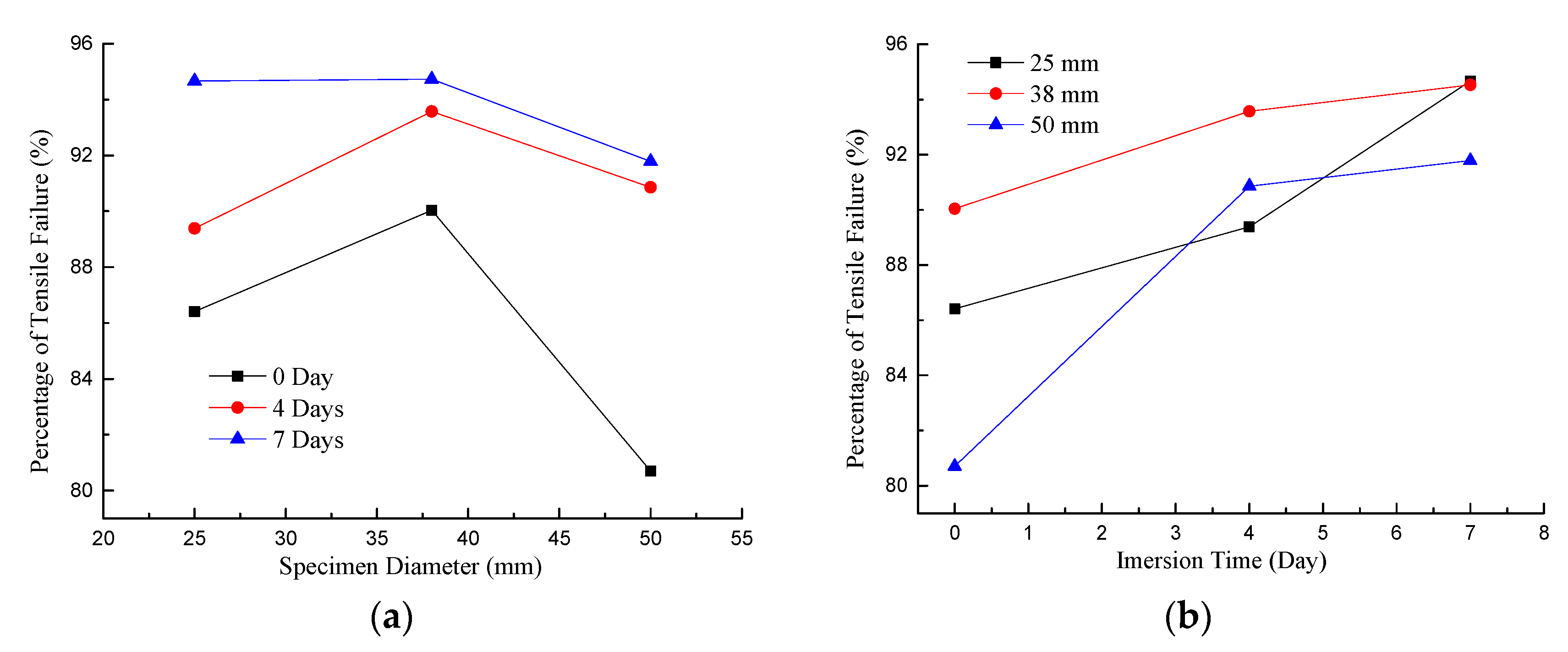

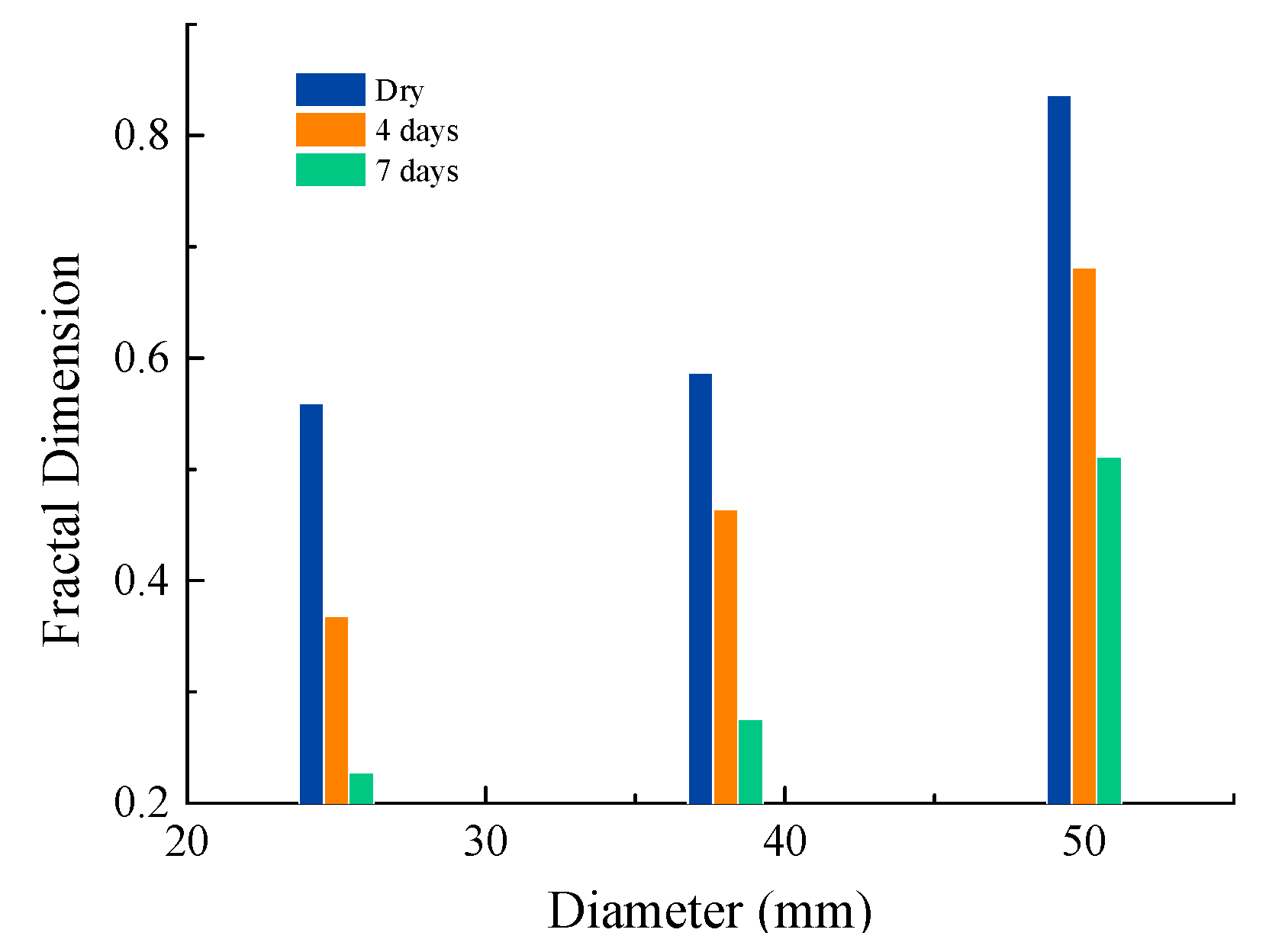

| Immersion Time (days) | Average Water Content (%) | ||
|---|---|---|---|
| 25 mm | 38 mm | 50 mm | |
| 4 | 4.80 | 3.98 | 3.31 |
| 7 | 5.56 | 4.59 | 3.89 |
| Immersion Time (Days) | 25 mm | 38 mm | 50 mm | |||
|---|---|---|---|---|---|---|
| Average Tensile Strength (MPa) | SD (MPa) | Average Tensile Strength (MPa) | SD (MPa) | Average Tensile Strength (MPa) | SD (MPa) | |
| 0 | 1.32 | 0.376 | 1.21 | 0.354 | 1.19 | 0.177 |
| 4 | 1.19 | 0.117 | 1.06 | 0.092 | 1.02 | 0.069 |
| 7 | 1.15 | 0.092 | 1.00 | 0.086 | 0.95 | 0.053 |
| Immersion Time (Days) | 25 mm | 38 mm | 50 mm | |||
|---|---|---|---|---|---|---|
| CAEC (×105) | CAEE (×105 aJ) | CAEC (×105) | CAEE (×105 aJ) | CAEC (×105) | CAEE (×105 aJ) | |
| 0 | 1.99 | 0.86 | 2.34 | 1.58 | 2.46 | 1.72 |
| 4 | 0.70 | 0.47 | 0.92 | 0.79 | 1.14 | 0.98 |
| 7 | 1.01 | 0.66 | 1.16 | 1.18 | 1.21 | 1.24 |
| Time (Days) | Fractal Dimension | |||||
|---|---|---|---|---|---|---|
| 25 mm | Average | 38 mm | Average | 50 mm | Average | |
| 0 | 0.26 | 0.55 | 0.67 | 0.58 | 0.92 | 0.83 |
| 0.20 | 0.60 | 1.12 | ||||
| 1.2 | 0.48 | 0.46 | ||||
| 4 | 0.68 | 0.37 | 0.37 | 0.46 | 0.62 | 0.68 |
| 0.18 | 0.69 | 0.85 | ||||
| 0.24 | 0.33 | 0.57 | ||||
| 7 | 0.05 | 0.23 | 0.34 | 0.31 | 0.35 | 0.51 |
| 0.49 | 0.44 | 0.39 | ||||
| 0.14 | 0.14 | 0.79 | ||||
| Dry | 4 Days | 7 Days | |
|---|---|---|---|
| A | 1.04 | 0.88 | 0.82 |
| B | 0.75 | 0.95 | 1.11 |
| k | 0.40 | 0.43 | 0.45 |
| Coefficient (R2) | 0.96 | 0.95 | 0.99 |
Publisher’s Note: MDPI stays neutral with regard to jurisdictional claims in published maps and institutional affiliations. |
© 2020 by the authors. Licensee MDPI, Basel, Switzerland. This article is an open access article distributed under the terms and conditions of the Creative Commons Attribution (CC BY) license (http://creativecommons.org/licenses/by/4.0/).
Share and Cite
Song, H.; Zhao, Y.; Jiang, Y.; Du, W. Experimental Investigation on the Tensile Strength of Coal: Consideration of the Specimen Size and Water Content. Energies 2020, 13, 6585. https://doi.org/10.3390/en13246585
Song H, Zhao Y, Jiang Y, Du W. Experimental Investigation on the Tensile Strength of Coal: Consideration of the Specimen Size and Water Content. Energies. 2020; 13(24):6585. https://doi.org/10.3390/en13246585
Chicago/Turabian StyleSong, Honghua, Yixin Zhao, Yaodong Jiang, and Weisheng Du. 2020. "Experimental Investigation on the Tensile Strength of Coal: Consideration of the Specimen Size and Water Content" Energies 13, no. 24: 6585. https://doi.org/10.3390/en13246585
APA StyleSong, H., Zhao, Y., Jiang, Y., & Du, W. (2020). Experimental Investigation on the Tensile Strength of Coal: Consideration of the Specimen Size and Water Content. Energies, 13(24), 6585. https://doi.org/10.3390/en13246585




